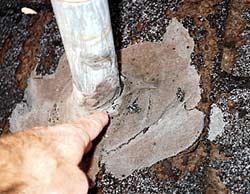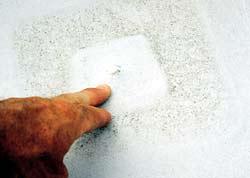
Troubleshooting Roof Leaks: Problems & Solutions

As an architect who has worked with the roofing industry since 1977, I often
inspect leaking roofs. I have found that poor flashing details - at
penetrations, at roof edges, or where a roof changes planes - are much more
likely to be the cause of a leak than the roofing itself. Similarly, many leaks
are caused by the use of insufficient or inadequate fasteners for sheathing,
flashing, or roofing, and by the attempt to substitute caulk or roofing cement
for flashing.
The cost of installing the roof on a new building usually amounts to less
than 5% of the total construction cost. Yet some lawyers estimate that 60% to
80% of construction lawsuits involve roof failures. Often, it's a small leak
that quickly grows into a big, expensive problem.
The following problems are among the most common I encounter. In every case,
the leak could have been avoided had the installer used and paid more attention
to detail.
Fasteners

Problem: No support at sheathing edges. The plywood sheathing
on this flat roof was installed without blocking under the edges. If someone
walks on the roof, the roofing may crack when the sheathing flexes at the
plywood joints.
Solution: Use H-clips or
solid blocking at plywood edges, or use tongue-and-groove plywood
roof sheathing.

Problem: Smooth-shank
nails don't hold. Smooth-shank common nails used to fasten roof
sheathing can work themselves loose over the years, especially if a roof deck
is walked on. Rising nail heads can eventually poke through the roofing.
Solution: Use ring-shank
nails for roof sheathing.
Problem: Flashing is
incorrectly fastened. There are three problems with the coping
flashing on this parapet wall:
The flashing has been fastened on the
horizontal face, instead of the vertical.
The flashing has been nailed
instead of screwed.
No allowance has been made for
expansion and contraction of the metal flashing, nor for
differential movement between the metal flashing and the wood nailer, which
expand at different rates.
An exposed fastener on the horizontal surface of the flashing is a potential
leakage point. If flashing is attached with nails instead of screws, the last
hammer blow can leave a concave dimple in the flashing, encouraging ponding
around the nail hole.
If long runs of flashing are installed without allowing for expansion and
contraction, the moving flashing can work nails back and forth until they
loosen.
Solution:
Attach flashing on a vertical surface rather than a horizontal
surface.
Use hex-head screws with neoprene washers rather than nails if
it is necessary to use exposed fasteners.
Install fasteners in slotted holes, which allow the flashing to
move with changes in temperature.
by Harrison McCampbell
This article has been provided by www.jlconline.com. JLC-Online is produced by the editors and publishers of The Journal of Light Construction, a monthly magazine serving residential and light-commercial builders, remodelers, designers, and other trade professionals.

|

